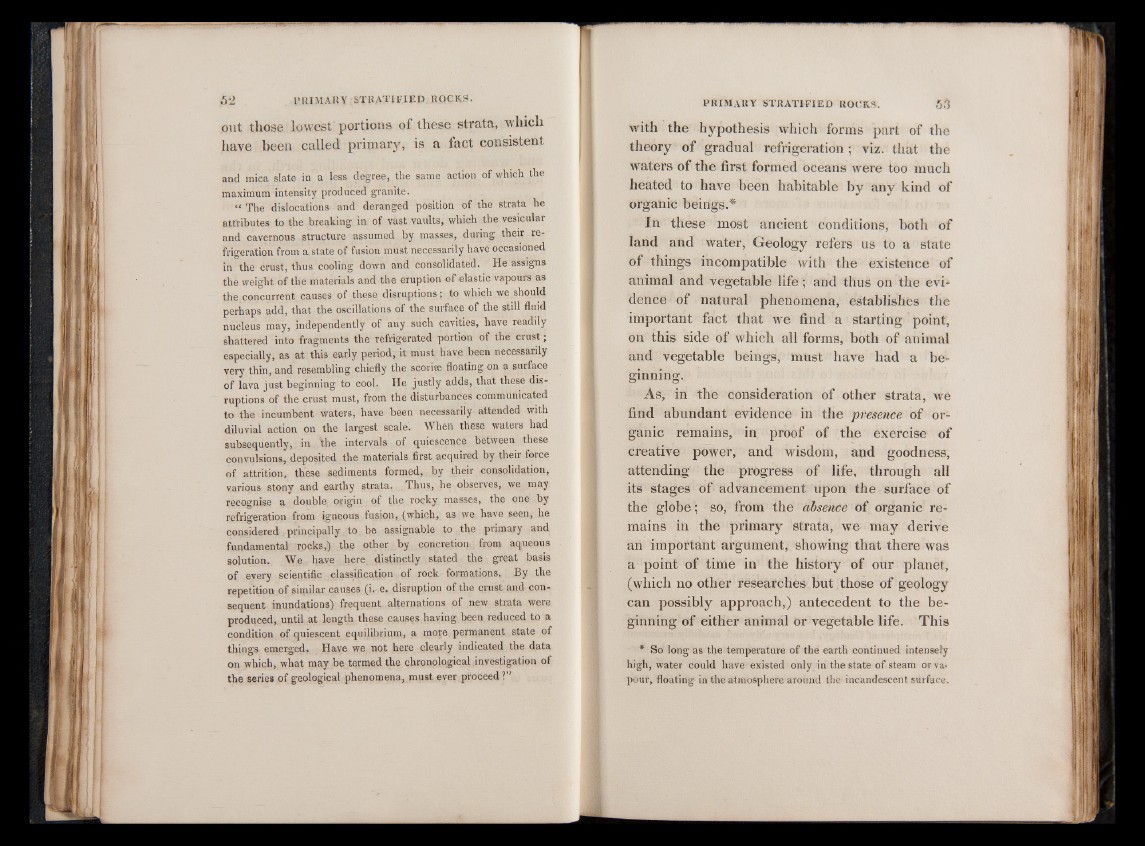
out those low e s t portions of these strata, which
have been called primary, is a fact consistent
and mica slate in a less degree, the same action of which the
maximum intensity produced granite.
“ The dislocations and deranged position of the strata he
attributes to the breaking in of vast vaults, which the vesicular
and cavernous structure assumed by masses, during their refrigeration
from a state of fusion must necessarily have occasioned
in the crust, thus cooling down and consolidated. He assigns
the weight of the materials and the eruption of elastic vapours as
the concurrent causes of these disruptions; to which we should
perhaps add, that the oscillations of the surface of the still fluid
nucleus may, independently of any such cavities, have readily
shattered into fragments the refrigerated portion of the crust;
especially, as at this early period, it must have been necessarily
very thin, and resembling chiefly the scoriae floating on a surface
of lava just beginning to cool. He justly adds, that these disruptions
of the crust must, from the disturbances communicated
to the incumbent waters, have been necessarily attended with
diluvial action on the largest scale. When these waters had
subsequently, in the intervals of quiescence between these
convulsions, deposited the materials first acquired by their force
of attrition, these sediments formed, by their consolidation,
various stony and earthy strata. Thus, he observes, we may
recognise a double origin of the rocky masses, the one by
refrigeration from igneous fusion, (which, as we have seen, he
considered. principally to be assignable to the primary and
fundamental rpcks,) the other by concretion from aqueous
solution. We have here distinctly stated the great basis
of every scientific classification of rock formations. By the
repetition of similar causes (i. e. disruption of the crust and consequent
inundations) frequent alternations of new strata were
produced, until at length these causes having been reduced to a
condition of quiescent equilibrium, a more permanent state of
things emerged. Have we not here clearly indicated the data
on which, what may be termed the chronological investigation of
the series of geological phenomena, must ever proceed?”
with the hypothesis which forms part of the
theory of gradual refrigeration; viz. that the
waters of the first formed oceans were too much
heated to have been habitable by any kind of
organic beings.*
In these most ancient conditions, both of
land and water, Geology refers us to a state
of things incompatible with the existence of
animal and vegetable life; and thus on the evidence
of natural phenomena, establishes the
important fact that we find a starting point,
on this side of which all forms, both of animal
and vegetable beings, must have had a beginning.
As, in the consideration of other strata, we
find abundant evidence in the presence of organic
remains, in proof of the exercise of
creative power, and wisdom, apd goodness,
attending the progress of life, through all
its stages of advancement upon the surface of
the globe; so, from the absence of organic remains
in the primary strata, we may derive
an important argument, showing that there was
a point of time in the history of our planet,
(which no other researches but those of geology
can possibly approach,) antecedent to the beginning
of either animal or vegetable life. This
* So long as the temperature of the earth continued intensely
high, water could have1 existed only in the state of steam or vapour,
floating in the atmosphere around the incandescent surface.